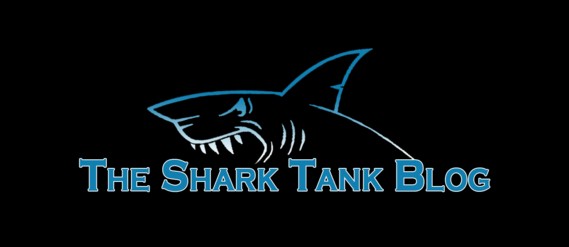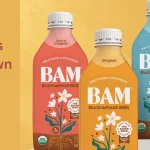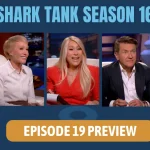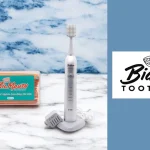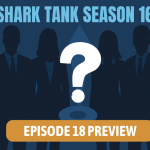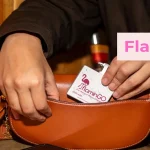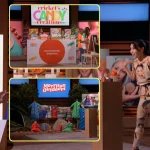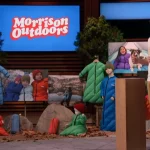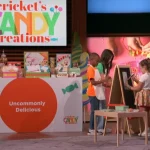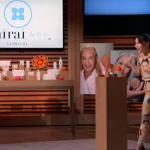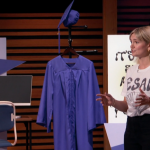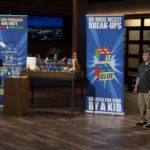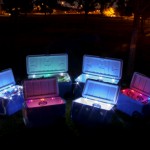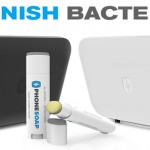Beyond the Tank Episode 207
 Beyond the Tank episode 207 aired Friday, May 13, 2016. Four businesses that previously appeared get an in-depth update on their progress since appearing on the show. Segments feature the entrepreneurs interacting with their investor/Sharks and viewers get to see the challenges they face as they propel their businesses forward. Beyond the Tank episode 207 features Bombas, the socially conscious sock company Daymond invested in during season six. Charles Michael Yim gives a more complete update from the one at CES 2016. Mark Peterson interacts with Robert, who invested $60K for 25% of the company in season six. Finally, Trina Barkouras shows the progress Hoppy Paws made since partnering with Barbara back in season six.
Beyond the Tank episode 207 aired Friday, May 13, 2016. Four businesses that previously appeared get an in-depth update on their progress since appearing on the show. Segments feature the entrepreneurs interacting with their investor/Sharks and viewers get to see the challenges they face as they propel their businesses forward. Beyond the Tank episode 207 features Bombas, the socially conscious sock company Daymond invested in during season six. Charles Michael Yim gives a more complete update from the one at CES 2016. Mark Peterson interacts with Robert, who invested $60K for 25% of the company in season six. Finally, Trina Barkouras shows the progress Hoppy Paws made since partnering with Barbara back in season six.
Each Episode of Beyond the Tank has these “back stories” and Shark Tank updates. We’ll recap them here.
Beyond the Tank Episode 207 Featured Sharks
- Investor – Barbara Corcoran
- Investor – Daymond John
- Investor – Robert Herjavec
- Investor – All Five Sharks
Beyond the TankEpisode 207 Featured Entrepreneurs
- Company – Bombas
- Company – Breathometer
- Company – Gold Rush Nugget Bucket
- Company – Hoppy Paws
Beyond the Tank Episode 207 Recap
Breathometer
Charles Yim brought his product, the Breathometer, to the Shark Tank in season 5. His smartphone breathalyzer device provides people with a spot-check of their level of intoxication, helping drinkers decide if it’s safe to drive after indulging. Mark Cuban liked the sensor technology, and offered $500,000 in return for 20% of the company.
Kevin O’Leary, not to be outmaneuvered, offers $250,000 in return for 15%. Robert Herjavec, sensing an opening, joins with Kevin to double the offer to $500,000 for 15%. Lori Greiner jumps in, offering another $250,000. Daymond John says he’ll go in if Mark Cuban is in. Cuban agrees, and Charles makes Shark Tank history, accepting a deal with all five Sharks for $1 million, in return for a total of 30% of his company.
“Charles really scored huge in the Shark Tank,” remembers Kevin. “Because he’s one of the only deals that ever got all five Sharks to invest. When you get five Sharks, you make history. I invested in Breathometer because it was a low-cost solution to a big problem.”
Previous to his appearance on Shark Tank, Charles had sold $200,000 worth of Breathometers. After his big win in the Tank, sales soared to a stratospheric $20 million. The instant success was a heavy blow to the company. It took six months for production to catch up with the intense demand, but Charles navigated the stormy waters and ramped up production to meet the orders.
Two years after appearing on Shark Tank, Breathometer has released two additional products and is about to launch a third. Over 120,000 units shipped in 2015 alone. The second product is called “Breeze.” It’s a blue-tooth version of Breathometer that requires less battery power and is wireless. While the first two products focusing on alcohol, the third, “Breathometer Mint,” is designed to measure the bacteria in the user’s mouth. Breathometer is partnering with Philips, a major oral health care company, to bring the Mint to the retail market.
The expansion has put a serious strain on Breathometer. The staff has grown from Charles and an engineer, to over 20 people. Kevin is coming to meet with Charles, to discuss the upcoming challenges and the future of the company.
In spite of Breathometer’s success, of the $1 million initial investment, the Sharks have yet to see a return on their collective investment. Kevin wants to know what is happening with the original product. Charles estimates that the original product currently represents only 10-20% of the company’s overall value. He explains that “Breathometer’s opportunity is really being a health care company.” Alcohol represents a $1 billion market. Oral health has a $15 billion market share. Charles believes that alcohol was the opening.
Kevin points out that, although Breathometer, on paper, is worth close to $50 million, the value is riding almost entirely on the new product.
“Charles has bet the farm on one product,” says Kevin. “If he doesn’t deliver, the Sharks have to go to the grave and kiss their money goodbye, and this company’s not worth anything anymore.”
Charles created deal with Philips that allows the company to both package the Mint with their existing products, and to sell it separately. He believes this strategy divides the risk, and hopes to reach $20 million in sales in the first quarter of the year. With Philips ordering 50,000 units for their first purchase order, he believes they will re-order 3 more times, bringing their total order to 200,000 units.
There are a lot of challenges to bringing a health care product to the market. They still have to achieve FDA approval before the product can be shipped. The production challenges they’ve faced in the past could be major hurdles if not solved moving forward. Charles acknowledges the challenges, but believes the company can rise to the challenge.
Kevin comes away more confident. “You know, here’s how I feel about Breathometer,” he says. “It didn’t deliver on its original vision, but I’m not writing him off yet. I think Mint is going to be huge. If Mint is a failure, he’ll be dead to me, because you can’t go to bat, strike out twice in a row, and get people excited about giving you even more money. That’s not going to happen. This is his last chance for romance.”
Bombas
Randy Goldberg and David Heath came to Shark Tank in season six. Their socks are designed to be more comfortable and effective, but they come with a unique tag: for every pair of socks sold, a pair is donated to New York City homeless shelters. In the 9 months the company had been in existence before appearing on Shark Tank, the pair had sold $450,000 of socks online. Daymond John made them an offer, and the Bombas partners landed a Shark deal.
“When you learn to master the online space,” says Daymond, “Your margins are huge, your inventory’s low, you’re selling direct to your customer, and I believe that in the next couple of years, these guys can go to $10 million, $20 million.”
In the six months since appearing on Shark Tank, the company has sold $1.6 million in Bombas. Randy and David are considering growing into retail locations. The move would mean increasing their staff of 12 to a much larger team. Randy’s unsure that the pair are the right people to grow Bombas into a multinational company. He feels that, as the company grows, the skills needed may outpace their own. The pair plan to meet with Daymond, to discuss the future of Bombas.
Daymond likes the new line, Bombas Solids, that the partners are rolling out. The new socks come in more traditional colors of black, white, and navy, than the original socks. The conversation soon turns to the idea of moving away from the online model and into retail spaces. David explains that they’ve been struggling with the idea. Daymond is against it.
“I think that retail is extremely dangerous,” he tells them.
The pair are willing to take risks, but Daymond is uncertain that’s the right way to go. He feels they can grow more quickly by staying online.
“Every time you go to retail,” says Daymond, “You get further away from the money.” Going into retail cuts the profit margin drastically. Daymond doesn’t believe they can sustain the model of giving away a pair of socks for every pair sold if they go into the retail space.
Currently, Bombas is on track to do $4 million in sales. Randy and David bring up their concern about their ability to run the company. “When a company reaches the $10 or $20 million level, they hit a headwall,” says Randy. “Then they have to start really against the big dogs – the Nikes and the Lululemons, and the Underarmors of the world.” The pair are considering whether they should sell out to a larger company that can take over and grow the company.
Daymond discourages the idea. “Throwing people at the problem doesn’t solve the problem,” he tells them. He believes they can make a success of Bombas. “End of the day, you guys are on fire,” he says. “I’m proud of it.”
The pair agrees to keep growing Bombas as an online retailer, and to continue following their dream.
“These guys are rock stars, and I love them,” says Daymond. “They are the ones with the talent, they understand the vision, and they’ve gotten to this point, which is the hardest point – they can take it anywhere after that.”
Gold Rush Nugget Bucket
Mark Peterson came to Shark Tank with his Gold Rush Nugget Bucket in season six. Robert Herjavec offered him a deal.
“Robert Herjavec would be the best Shark for the Gold Rush Nugget Bucket,” says Mark, “Because he has a history of investing in outdoor and fun products.”
Robert, for his part, was excited about his investment. “I invested in Mark and Gold Rush Nugget Bucket,” he says, “Because I love the product. I thought it was fun. Mark was deeply passionate about it, which I always love, and I thought we could make some money.”
Prior to Shark Tank, Mark had sold about $165,000 worth of his buckets. After the appearance, sales leapt to $320,000. With 98% of sales online, Mark feels as if he needs to master social media and grow his online presence. He intends to meet with Robert, to discuss the future of the company and how to move forward.
Sales have grown about 3.5 times from the original. The Gold Rush Nugget Bucket has reached 28 countries and six continents. Robert feels the price point is solid, and that Mark needs to engage with the existing customer base.
Gold Rush Nugget Bucket has only 300 followers on Instagram. “My girlfriend’s dog has more followers than you,” jokes Robert, but he quickly turns serious. “In today’s day and age,” he tells Mark, “Social media can fundamentally alter your business.”
Robert feels that there is a lot of room for improvement of the social media presence. Mark says that he intends to hire a digital media manager to handle the social media side of Gold Rush Nugget Bucket. Robert agrees that would be a strong move for the company. He feels that outsourcing the social media side of the business would free Mark to focus on distribution and expansion. He also believes that Gold Rush Nugget Bucket needs to move into retail spaces, but not just any retail. He wants Mark to focus on regional outlets where mining is a part of the local culture.
“Not all retail is equal,” says Robert. “A lot of people come on Shark Tank, and they think, I want to go after big retail. Sometimes, niche, vertical retail is better for you.”
Mark comes away with new hope and ambition. “I feel like, with the tools and advice that Robert has given me, I have new clarity. I’m gonna take the company to the next level.”
Hoppy Paws
Trina Brakouras came to Shark Tank in season six. The stamping kits allow parents to create “foot prints” of bunnies and reindeer, to engage children’s imaginations and increase the magic of Christmas, Easter, and other holidays. When Trina came into the Tank, her product and company were a mere 90 days old. The revelation that her product was a true startup led Mark Cuban to christen her “The Beast.”
The Sharks were impressed by her drive and quick success, but Barbara Corcoran wants to know if Trina would consider limiting the number of products she’s offering. She has 8 SKUs currently, a number Barbara finds excessive considering the scope of the business. In spite of Trina’s reluctance to cut down on the number of products, Barbara made her an offer.
“It’s difficult,” says Barbara, “To invest in a brand-new business, because you can expect that the entrepreneur is going to make all the usual beginner mistakes. But, I invested in this business because Trina was clearly the best salesperson I’ve ever seen on Shark Tank.”
Trina started Hoppy Paws to eradicate the memories of her own less-happy childhood, and to create something new for her own daughters. When her brother passed away in a car accident at age 19, it created a dark time for her family. She wanted to create happy memories and a strong foundation for her own two daughters. “That’s why I started my company. I wanted to create happy childhoods for all children,” she says.
Because the product was brand-new as of her Shark Tank appearance, Trina had zero sales prior to the show. After Shark Tank, she had to fulfill 6,000 orders that came in through her website. Major retailers began approaching her, and she’s waiting on purchase orders. She’s waiting to clear a sales test in 24 Target stores for Halloween. If the product does well, Hoppy Paws will roll out to all 1,700 Target stores in time for Easter.
Trina intends to meet with Barbara, to discuss strategy and the future of her company. “Right now, it’s make or break for Hoppy Paws,” she says.
Barbara comes to the meeting with a focus on which products are likely to be successful and which should be removed from the line. Trina presents her current Easter Bunny footprints kit, and then starts introducing her spinoff products: candy Easter Bunny “poop” and an Easter Bunny Crossing sign. She also has a reindeer crossing sign.
Barbara is a bit overwhelmed. “I love the creativity,” she says, “But I want to say, ‘Stop!’ Your most favorite thing is the new idea, but when you’re spending that time, you’re not out doing the other thing that is your great gift. You can sell.”
Trina says “I don’t want to sell,” shocking Barbara. “My forte is the creativity. My forte is getting organized and looking beautiful.”
Barbara “whole heartedly disagrees.” She tells Trina that, when she walked off stage, the other Sharks agreed that she was one of the best salespeople they’d ever seen on Shark Tank.
Trina explains that she’s hired representatives to go out and sell the product. Barbara tells her that she shouldn’t rely on the reps. “They’re the sales force that half-believes,” she says. “You’re the sales force that totally believes, with your life riding on it.”
Trina understands Barbara’s concern, and agrees to do more of the sales herself.
Barbara is concerned that the focus for the Target test is Halloween. She feels the Easter Bunny, Tooth Fairy, and reindeer prints are the top three sellers, and worries that the monster prints aren’t a strong enough product for the test. She tells Trina to call the representative and attempt to switch the Halloween test to a Christmas test, so that they can promote a stronger seller – the reindeer print. She offers to intervene if Target refuses to change the test, and use her leverage to ensure Hoppy Paws has a stronger chance at getting its foot in the door with Target.
“The Target deal can make or break any company,” says Trina. “Just that one account would be more revenue in all of 2014 and 2015 combined. You only get one chance with these retailers, and if you don’t perform, you’re out.”
Trina takes Barbara’s advice, and approaches Target about the change. Target wants to keep the Halloween test, but they also agree to allow Hoppy Paws to roll out at Christmas, giving them a second shot at the roll out.
“Obviously, it’s tough to run a business,“ says Trina. “But I want my kids to learn that, you know, life isn’t always easy, but you don’t give up, you don’t quit, and you make your life what it is.”
With luck, Hoppy Paws will move forward on a path to success.

